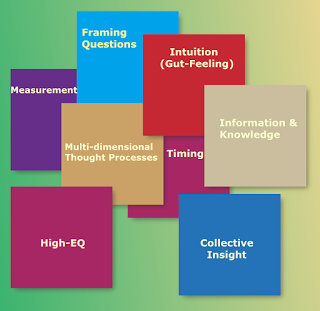“Decision Master” Book Introduction Chapter 2: Decision-Making Principles
 Digital is about the increasing pace of changes and overwhelming information. One significant effect of digitization is increased velocity, complexity, ambiguity, unpredictability, and a need for a faster response to changes in businesses and industries based on effective and efficient decision making. Decision making is both art and science, making either strategic or tactical decision effectively is one of the most critical responsibilities facing them every day. How to set principles and guidelines for reaching the high level of decision maturity in your organization?
Digital is about the increasing pace of changes and overwhelming information. One significant effect of digitization is increased velocity, complexity, ambiguity, unpredictability, and a need for a faster response to changes in businesses and industries based on effective and efficient decision making. Decision making is both art and science, making either strategic or tactical decision effectively is one of the most critical responsibilities facing them every day. How to set principles and guidelines for reaching the high level of decision maturity in your organization?
Part of problem for decision-making has to do with how you frame the question: Inappropriate framing is being the root cause of most bad decisions. Often time people rush up to make decisions or jump to a conclusion even without understanding the real issues. Many times, framing the right question is one of the most crucial step in decision-making. It’s the step decision makers can slow down and think through the implication of their subjective assumptions. This is particularly important for strategic decision-making. The approach is to offer people a consistent process that enables them to access relevant information to inform the decision, weigh up the alternatives, and develop the insights that guide their final decisions. So, the great leaders are surrounding themselves with people who can contribute to framing the decision, and then procure the resources for that decision to be enacted.
You have to be selective for getting the right information and capturing the valuable insight in making decisions: Decision is about future, and future is full of uncertainty. Information and decision-making are intimately connected and interdependent. The information allows you to build an actionable insight on how to move from one level to the other. Information as input to the decision-making does not absolutely determine the decision but allows the decision-maker to exercise their judgment. It applies to the context and environment in which decisions are made. For decision-making to be effective, the decision-maker must have enough knowledge to make their decisions rich in information and significantly different from the available data. Because how effective the decision in depends on how capable the decision maker can climb the knowledge pyramid from data to information to insight and wisdom.
 Making timely decisions: As old saying goes: A wrong decision taken at the right time is better than a right decision taken at the wrong time. Timing is always critical for decision-making effectiveness. Each decision is subject to the conditions under which it was taken via the requirements of the person taking the decision. You do not and can’t afford to defer the decision until such time that all facts and information are available. Decision are necessary as a result of limited resources in time, knowledge, capital, and people. Behind every decision, there is always an element of uncertainty and doubt. It is up to the decision-maker how he or she handles it. But significantly, decisions are to be made on time, and this is more imperative when uncertainty and doubts are major hindrances to decision making. No decision in the world outlives the time, place, and the person’s constituents on basis of which it was made.
Making timely decisions: As old saying goes: A wrong decision taken at the right time is better than a right decision taken at the wrong time. Timing is always critical for decision-making effectiveness. Each decision is subject to the conditions under which it was taken via the requirements of the person taking the decision. You do not and can’t afford to defer the decision until such time that all facts and information are available. Decision are necessary as a result of limited resources in time, knowledge, capital, and people. Behind every decision, there is always an element of uncertainty and doubt. It is up to the decision-maker how he or she handles it. But significantly, decisions are to be made on time, and this is more imperative when uncertainty and doubts are major hindrances to decision making. No decision in the world outlives the time, place, and the person’s constituents on basis of which it was made.Digital maturity is to ensure that the right decisions have been made by the right people at the right time. Ultimately, you should remember each decision is subject to the conditions under which it was taken. It is important for setting principles to make an assessment of decision-making scenario and developing the frameworks and practices to improve decision maturity. Follow us at: @Pearl_Zhu
Published on January 27, 2017 22:59
No comments have been added yet.



